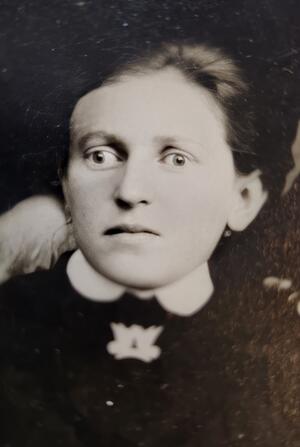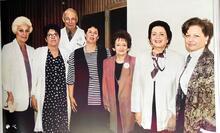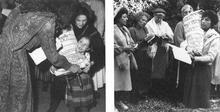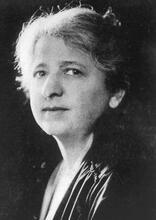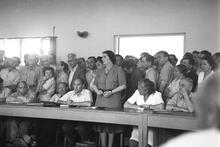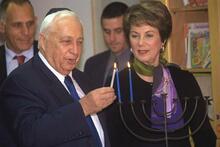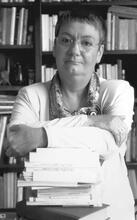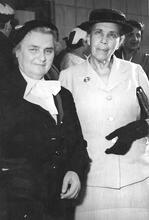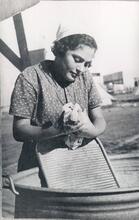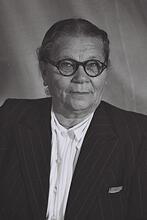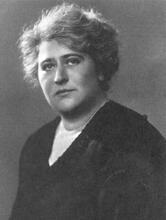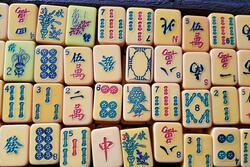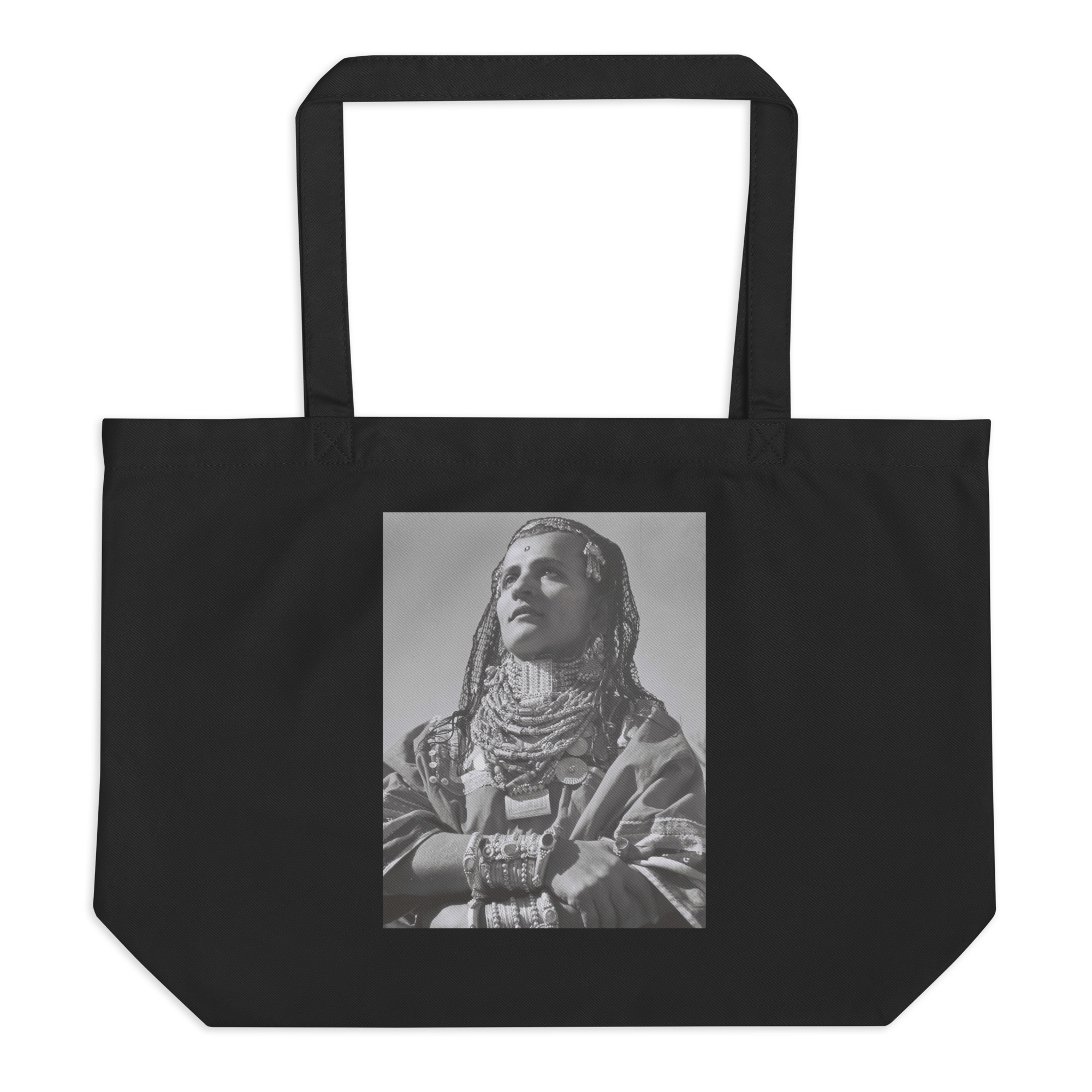Adina Kahansky
Lithuanian-born Adina Kahansky was a leading activist for women’s rights and a Jewish homeland in pre-state Israel. In 1894, Kahansky emigrated to Argentina to join her father, who had previously settled in the Jewish colony of San Antonio. She arrived in Erez Israel in 1902 and settled in Rishon le-Zion. Kahansky was among the first women in Erez Israel to be elected to a moshavah council. She joined women's organizations and extensively published in the Hebrew press, tirelessly advocating for women’s rights, social justice, and a Jewish state, combining feminism and Zionism. Her writings provide insight into events in Erez Israel during the first half of the twentieth century from an active woman’s perspective.
Early Life and Education
Adina Kahansky was born in Vilkaviškis, Lithuania, in 1887, to Sheina-Treina Abramson (1859-1943) and Jacob Yehoshua Kahansky (1857-1902), a religiously devout couple who managed a small bakery in their hometown. In 1891, when Kahansky was four years old, her father embarked on a journey towards Ottoman The Land of IsraelErez Israel. Due to the entry ban imposed by the regime, he eventually sailed to the Jewish Colonization Association (JCA) agricultural settlements in Argentina. After receiving a plot of land in the San Antonio colony, he requested that his family join him.
Adina Kahansky emigrated to Argentina in 1894 along with her mother, sister Tova (1889-1968), and brothers Michael (1883-1957) and Mordechai (1891-1969). She attended the local school and later attended high school in Buenos Aires. To attend school in the big city, she might have had help from Fenia Chortkoff, a socialist and feminist teacher and founder of the school and library in the neighboring Clara colony, who may have noticed her intellectual abilities; they may have been in touch later in Kahansky’s life. During this time, she increased her engagement with Argentinian culture and the liberal, socialist, and feminist ideas that flourished at the time. All of these likely had an impact on her later life.
In 1902, spurred by Jacob Yehoshua Kahansky’s longing for The Land of IsraelErez Israel, the family emigrated to Ottoman Erez Israel, and settled in Rishon-le-Zion, then a new agricultural colony built by pioneer Jews from Eastern Europe, where her father's relatives lived. Michael Kahansky remained in Argentina and started a family; Adina Kahansky, who never married, was always thrilled to receive news about her brother's family and the Argentine Jewish colonies.
Early Years in Rishon le-Zion
Kahansky’s father passed away six months following the family’s arrival in Ottoman Erez Israel. Soon after, the family set up a modest bakery and later a bookstore and guesthouse. Children who attended the first all-Hebrew school bought their textbooks at their bookstore, and the Lit. "village." The dominant pioneer settlement type of the Jews in Palestine between 1882moshavah residents could read the latest news and publications. The bookstore became the meeting place for the second Aliyah pioneers and pro-Hebrew language activists who visited the first Hebrew-speaking Lit. "village." The dominant pioneer settlement type of the Jews in Palestine between 1882moshavah.
Kahansky devoted herself to the Hebrew language, which she considered essential in the quest for a national home. In a 1933 letter to poet Chaim Nachman Bialik (1873-1934) in honor of his 60th birthday, Kahansky recalls a defining moment when, in 1906, she first read the Yiddish translation of Bialik’s poem In the City of Slaughter and realized the importance of reading it in the original Hebrew version. Kahansky learned Hebrew and began publishing small articles in A-Poel Ha-Zair, a newspaper published by a socialist Zionist group that sought to peacefully establish a new Jewish society through manual labor and communal settlements. She later moved on to other Hebrew publications such as Haaretz, Ha-Boker, and the women's journal Ha-Isha.
Women's Rights Activism in the Moshavah Rishon-le-Zion
In Rishon le-Zion, Kahansky soon became involved in women’s rights activism. She met Nehamah Pukhachewsky (1869-1934), who, with other women, began to organize areas of the moshavah that most men considered feminine, such as caring for children, the sick, and the elderly. Through these women, Kahansky discovered the value of public activity. By 1906, she had joined the Dvorah Association, founded in 1897 and named after Dvorah Ben-Yehuda, the late wife of Eliezer Ben-Yehuda, the primary driving force behind the revival of the Hebrew language; there, she took Hebrew classes from Pukhachewsky and participated in cultural activities aimed at empowering women and enhancing their abilities, intending to shape the “new Hebrew children.” Kahansky also joined the Linat Ha-Tzedek, a social welfare organization, founded in 1899 as a women’s organization but later joined by men. The women helped meet the community's needs, providing medical aid and social services to the sick, widows, elderly, and new immigrants. In 1909, the women's organizations assisted new Yemenite immigrants, providing them with agricultural and domestic work, Hebrew classes, and instruction for young mothers.
In 1911, the women of Rishon le-Zion founded the Agudat Nashim Ivriot. This local Hebrew Women’s Association began as an association for cultural and literary affairs but eventually held debates on political issues, including the “women’s question.” Believing that gender equality would strengthen the Jewish population in Palestine in its struggle for a Jewish homeland, Kahansky considered it necessary to convince all women of its importance.
Following the Balfour Declaration and World War I, the moshavah Rishon le-Zion grew in population. The local women’s organizations expanded their welfare activities accordingly, while also demanding equal rights. In her memoir, Kahansky narrates how, in 1917, a handful of women founded the Itachdut Nashim Ivriot le Shovi Zchuiot in Rishon le-Zion, a local Hebrew Women's Union for Equal Rights with the sole goal of achieving equality for women, the first organization of its kind in the land. The group regularly attended meetings of the Moshavah Council to exercise the freedom of expression guaranteed to all Rishon Le-Zion residents, and to persuade men to grant women the right to vote and be elected to the local council.
The Rishon le-Zion Women’s Union for Equal Rights officially raised the issue of women’s suffrage when it sent its demands in writing to Rishon le-Zion’s general assembly on November 24, 1917, stating that the new era required social change. Kahansky describes in her memoirs how the politically active women met resistance from men and indifference from some women. Discussions lasted about two years; in 1919, the parties agreed on a special clause to be included in the Council’s regulations, according to which seats would be awarded to the two women who received the most votes among the women candidates. Pukhachewsky and Kahansky were nominated as candidates for the elections that took place on December 7, 1919. After a long and tense vote count, to everyone's surprise, Pukhachewsky received the most votes among all the candidates, followed by Kahansky. Pukhachewsky gave up her right to become chair of the council in favor of the broader suffragist struggle, but both women served as council members. Kahansky served in this role for fifteen years, participating in the elections, school, and loan and savings committees.
Women's Rights Activism in the Yishuv
Of course, the struggle for women’s rights did not remain within the confines of the moshavah. The Rishon le-Zion Women’s Union for Equal Rights joined forces with the national women's rights union, taking part in the suffragist movement for the general assembly of the Jewish community in Palestine prior to the establishment of the State of Israel. "Old Yishuv" refers to the Jewish community prior to 1882; "New Yishuv" to that following 1882.Yishuv as well. Additionally, in 1920, Rishon le-Zion's Agudat Nashim Ivriot became a branch of the national Histadrut Nashim Ivriot, which merged in 1933 with the Women’s International Zionist Organization (WIZO). In 1927, following the second Constituent Assembly decree of January 1926 granting equal rights for women in all areas of civil, economic, and political life in the Yishuv, Kahansky helped set up a Women's Organizations Council, which aimed to coordinate the activities of all women's organizations. Kahansky participated in the Council as a member of the Union of Hebrew Women for Equal Rights in Erez Israel and was elected to a founding committee tasked with setting up the council’s norms and rules. In 1931, Kahansky appeared in 12th place on the joint Histadrut Nashim Ivriot and Union of Hebrew Women for Equal Rights candidate list for the General Assembly of the Yishuv, led by Henrietta Szold; the candidates promoted the need for institutionalized social work. Eventually, Szold, Sara Azaryahu, and Helena Kagan were elected and carried on their project with the women's council's support.
Through the years, along with her demand for much-needed social aid to women and children, Kahansky was particularly concerned with the status of women under religious law and looked to reform discriminatory practices, particularly concerning polygamy and the economic aspects of marriage, divorce, and inheritance.
On the Brink of a Jewish State
During the 1910s and 1920s, Kahansky admired the vision and courage of the Second Aliyah pioneers and ideological leaders and sympathized with the socialist Zionist group Ha-Poel Ha-Tzair. Later, however, her political views took a turn to the right and came in line with the political views of the liberal revisionist party Brit Hatzo'ar. Brit Hatzo’ar insisted on the Jewish right to sovereignty over the entire biblical land of Israel and was the main ideological opponent to the ruling socialist Labor Zionists, clashing over not only their visions for a Jewish state and but also the means through which this state should be achieved. However, in archival records, Kahansky claims she was never a formal member of any political party, describing herself as neutral and a free thinker who expressed her opinions according to her views.
Kahansky’s shift towards a revisionist political point of view appears to have intensified in 1933, following the assassination of Haim Arlosoroff (1899-1933), a Socialist Zionist leader of the Yishuv, for which two revisionist Jews were blamed; it grew even more intense with the Arab uprising of 1936. Eventually, in 1941, Kahansky became head of the Rishon-le-Zion branch of the Tel-Hai Fund, the Revisionist Party's financial arm. Kahansky's alignment with Brit Hatzo'ar reflects her growing frustration with the socialist movement's policies, which she viewed as ineffective in the face of the Arab uprising and the British limitations on Jewish immigration and land ownership. Kahansky advocated on behalf of women from the Yishuv with similar opinions, for increased Jewish self-defense, opposition to partition plans, and the demand that all oppressed Jews in Europe be allowed to enter Palestine with the ultimate goal of creating a Jewish national homeland as a solution for Jewish suffering.
Legacy
After dedicating her entire life to public service and witnessing the 1948 creation of the State of Israel, Kahansky wrote her memoirs about the struggle for women's equal rights. She pointed out how the battle for equality coincided with the efforts to create a Jewish state, knowing that she had helped break conventions that prevented women from living full lives.
Kahansky envisioned a society where women could fully take part in all facets of life, bringing their unique skills and perspectives to the collective efforts of building a Jewish state. As a member of the civil sector of the Yishuv who believed that women should not mimic men but rather value their feminine qualities, it was important for her that all women's contributions to nation-building efforts, whether as housewives or as Poalot (women workers), should be recognized and valued as equal to those of men.
Adina Kahansky died of illness on May 7, 1950. The inscription on her grave reads: “She dedicated her whole life to public affairs.” Kahansky’s life story exemplifies the dedication and tenacity of women who fought for their rights despite facing social, religious, and political barriers, while significantly contributing to the transition from the Yishuv to the State of Israel.
Archival material
Museum & Historical Archives of the Jewish Colonies.
Central Zionist Archive.
Beit Bialik Archive.
Rishon-le-Zion Archive.
Private archives.
Secondary sources
Avni, Haim. Argentina and the Jews: A History of Jewish Immigration. Tuscaloosa, AL: University of Alabama Press, 1991.
Azaryahu, Sarah. The Union of Hebrew Women for Equal Rights in Eretz Israel. Haifa: 1977 [Hebrew; first published in 1949].
Bernstein, Deborah S. (ed.). Pioneers and Homemakers: Jewish Women in Pre-State Israel, Albany, NY: State University of New York, 1992.
Berlovitz, Yaffa (ed.). Stories of the Women of the First Aliyah. Tel Aviv: 1984 [Hebrew].
Gruweis-Kovalsky, Ofira. 'Hebrew Women Don't Lose your Share': Secular Right-Wing Zionist Women in the Transition to Statehood. Ramat Gan: Bar-Ilan University Press 2023 [Hebrew].
Guvrin, Nurit. “Women in the Hebrew Press – Beginnings.” Kesher 28 (2000): 8-20 [Hebrew].
Idelovitch, David. Rishon-le-Zion 1882-1941. Rishon-le-Zion: 1941 [Hebrew].
Kahansky, Adina. “Different Ways of Social Supervision.” Ha-Isha 3 (1926): 32 [Hebrew].
Levy Ziv-Bar, Miri and Ivy Sichel. “Women’s Contribution to the Creation of a Hebrew-Speaking Community During the First Aliyah. Cathedra 169 (2018): 75-108 [Hebrew].
Margalit Stern, Bat-Sheva “‘No barrier to the unison of hearts’: cross-class and nation coalition of Zionist women in the wake of statehood.” Israel Affairs, 24, 2018.
McGee-Deutsch, Sandra. Crossing Borders, Claiming a Nation: A History of Argentine Jewish Women, 1880-1955. Durham, NC: Duke University Press 2010.
Rishon-le-Zion Museum. “In Her Shoes”: exhibition in honor of 100 years of equal rights for women in Rishon-le-Zion, for the first time in Eretz Israel. Rishon-le-Zion: 2009 [Hebrew].
Shilo, Margalit. “The Transformation of the Role of Women in the First Aliyah, 1882-1903.” Jewish Social Studies 2 (1996): 64-86 [Hebrew].
Shilo, Margalit. Girls of Liberty: The Struggle for Suffrage in Mandatory Palestine. Waltham, MA: Brandeis University Press, 2016.
Tidhar, David. Encyclopedia of Pioneers and Builders of the Yishuv. Vol. 5. Tel Aviv: 1952 [Hebrew].

